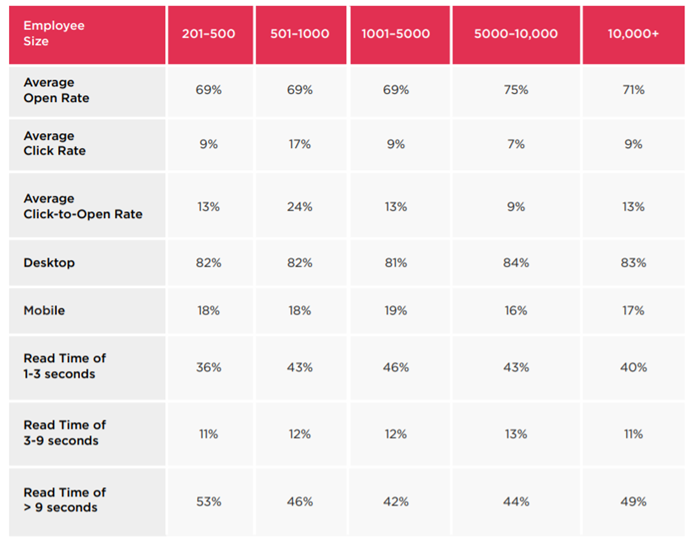Although there are many apps and tools to facilitate internal communications, recent data shows that email is still THE primary channel in most organizations.
Especially in the last two years, we have seen a high increase in email usage. The proof is in the numbers.
- Internal communicators sent 72% more emails in 2020 than in 2019.
- Employees read 44% more minutes of emails in 2020 and clicked 82% more links.
- 71% of internal communicators relied more on email during the pandemic.
- 95% of internal communicators indicated email was the key communication channel.
- Email metrics are in the in the top 3 internal communications KPIs for 2020.
- 77% of employees prefer using emails for work vs. 23% of employees choose messaging apps.
- Overall employee engagement with the medium increased 71%.
Clearly, email isn’t going away. It even proved to be an effective, yet low-cost way to communicate with the workforce.
Studies show that corporate communicators have had good intentions. They are making an effort to connect during these challenging times. On the flip side, there’s often a feeling of email overload.
The average employee spends 28% of the work week reading and answering email, compared with 39% of working hours on actual job-related tasks, according to McKinsey research. “Of the employee audience, 60% will read 77% of it. Of recipients who open and don’t ignore the message, 20% will skim the content, reading less than 30%.”
The challenge for internal communicators is to increase employee engagement by creating more engaging internal emails.
7 tips for engaging internal emails
How do you avoid messages being ignored by employees? What makes people open and read the information?
Keep these tips in mind when sending your next internal email.
1. Make it easy to digest
Your colleagues are busy. They simply don’t have time to read a long-written email. So, try to keep your email short and concise.
Take this tip from copywriters: Write in lines, not paragraphs. That will make your content easier and faster to skim through.
If you have a lot to say or it’s an important announcement with many details, think of how you can simplify the message. For example, use bullet points and subheadings to present your content. If possible, add a link to the presentation or article that provides a deeper explanation.
What about the length of the message? Use this stat “111 words is the length of the message where 49% of people will stop reading”—as a benchmark.
2. Keep it relevant and personal
Most of us receive tons of emails a day. Avoid sending multiple emails in one day and make sure the right messages reach the right audiences.
People ignore emails when they are redundant, unimportant, or irrelevant to them.
One best practice is to segment your audience and start creating targeted, segmented messages. By doing this, you will see an increase in email engagement.
3. Be thoughtful about your subject lines
Needless to say, the subject line is super important because it has a great impact on the open rate of your email.
Again, since your colleagues are receiving a lot of emails each day, make sure your emails grab their attention with a good subject. Here are some tips for effective internal email subject lines.
- Keep it short and sweet. Research has found that emails with a 6-10 words subject line have the highest open rates.
- Make it personal. For example, which email subject do you think would get a higher open rate? A) New policy or B) New policy that impacts you, {Name}!
- Make sure your emails are displayed correctly on mobile.
- Make your emails actionable by using action verbs, asking questions or creating urgency.
- Test different subject lines.
4. Try using visual content
Visual content is way more engaging than text. Consider using them more in your internal emails.
Presentations, images, videos or infographics; these are great visual content forms you can use in your communication.
Using video for internal communication is highly recommended because viewers are likely to retain 95% of a message when they watch a video, compared to 10% when reading it in text. You can use video content for onboarding, training, updates and announcements from the leadership, etc.
5. Involve your audience
Struggling to come up with new ideas or topics for your employee newsletter?
Including an employee survey in the internal email can be a great way to generate more ideas. Ask employees what interests them, or what they actually want to read. Your employees have a lot of great ideas and suggestions to share.
Consider offering an incentive to everyone who contributes an idea. It will help to promote an idea sharing culture in your organization.
6. Keep track of your email metrics
The open rate, click-rate and click-through-open rate are important metrics for email communications. Keep track and analyze this data on a consistent basis to improve the performance of your internal emails. For example, adjust the timing and frequency of your emails to optimize their performance.
For your reference, these are the average internal email metrics by employee size in Ragan’s report 2021.

Another way is to conduct a periodic employee pulse survey to understand how well your emails are being received and read. Allow your colleagues to share their feedback and thoughts.
7. Integrate with other communication channels
In most organizations, employees use multiple tools and applications to communicate and collaborate. So, it’s important that these technologies are well integrated and can work together smoothly.
If you’re already using Outlook for email, Involv intranet is a great intranet solution for your employees and organization.
Its integrations with Microsoft 365 applications are fantastic. For example, users can check their inbox directly from the intranet. Involv also allows intranet admins to send email notifications to employees’ inboxes without leaving the platform.
Learn more about Involv intranet and how it can help to improve your internal communication. Schedule your free demo.
(image: Freepik)

Tim Bogemans
Your Plan for Maximizing Employee Engagement
-
STEP 1. SCHEDULE YOUR DEMO
Get a demo and gain valuable insights in how the Involv intranet builds adoption.
-
STEP 2. CREATE A ROLLOUT PLAN
Together we co-create a rollout plan tailor made for your organization.
-
STEP 3. LAUNCH YOUR INTRANET
You’re all set to launch your intranet and get everybody involved.
-
STEP 4. ACHIEVE HIGH EMPLOYEE ENGAGEMENT
Use your Involv intranet to communicate effectively and engage employees.


